Edward Bawden, CBE, RA (1903 – 1989) was a British painter, illustrator and graphic artist, known for his prints, book covers, posters, and garden metalwork furniture. He was admired by Edward Gorey, David Gentleman and other graphic artists.
He was admired by Edward Gorey, David Gentleman and other graphic artists.
 , Essex, the only child of Edward Bawden (ironmonger) and Eleanor Bawden (née Game). His parents were Methodist Christians.
, Essex, the only child of Edward Bawden (ironmonger) and Eleanor Bawden (née Game). His parents were Methodist Christians.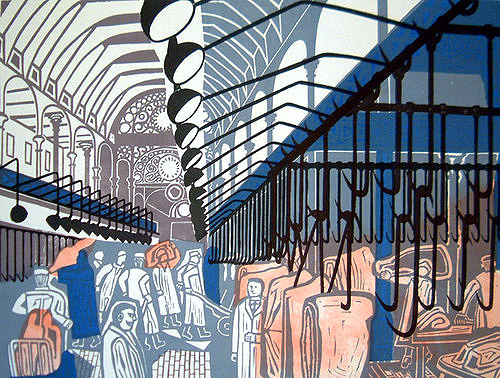 A solitary child he spent much time drawing or wandering with butterfly-net and microscope. At the age of seven he was enrolled at Braintree High School, and began studying or copying drawings of cats by Louis Wain,
A solitary child he spent much time drawing or wandering with butterfly-net and microscope. At the age of seven he was enrolled at Braintree High School, and began studying or copying drawings of cats by Louis Wain, illustrations in boys' and girls' magazines and Burne Jones's illustrations of Malory's Morte d'Arthur. Later his parents paid for him to attend the Friends' School at Saffron Walden,
illustrations in boys' and girls' magazines and Burne Jones's illustrations of Malory's Morte d'Arthur. Later his parents paid for him to attend the Friends' School at Saffron Walden, and there, when he was fifteen, the headmaster recommended him to study for one day a week at Cambridge Municipal Art School (now Anglia Ruskin University). On leaving school in 1919 he attended the Cambridge School of Art full-time (1919 to 1921). Here he became interested in calligraphy and in the work of
and there, when he was fifteen, the headmaster recommended him to study for one day a week at Cambridge Municipal Art School (now Anglia Ruskin University). On leaving school in 1919 he attended the Cambridge School of Art full-time (1919 to 1921). Here he became interested in calligraphy and in the work of 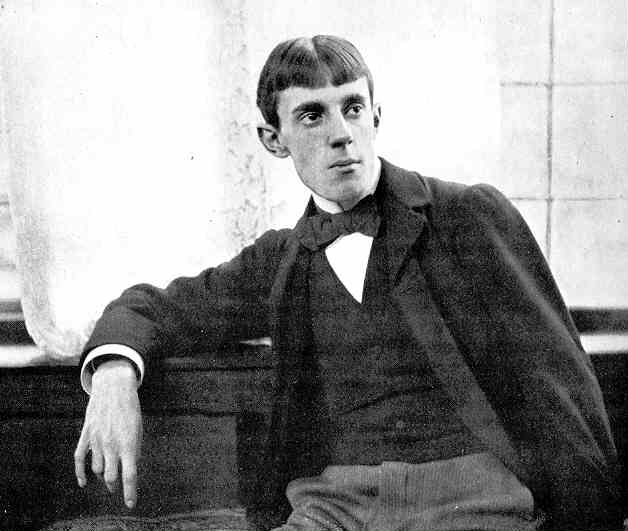 Aubrey Beardsley, Richard Doyle, William Morris and other Victorians. This was followed in 1922 by a scholarship to the Royal College of Art School of Design in London, where he took a diploma in illustration until 1925.Here he met his fellow student and future collaborator,
Aubrey Beardsley, Richard Doyle, William Morris and other Victorians. This was followed in 1922 by a scholarship to the Royal College of Art School of Design in London, where he took a diploma in illustration until 1925.Here he met his fellow student and future collaborator,  Eric Ravilious; the pair were described by their teacher, Paul Nash, as "an extraordinary outbreak of talent
Eric Ravilious; the pair were described by their teacher, Paul Nash, as "an extraordinary outbreak of talent
By 1930 Bawden was working one day a week for the Curwen Press (as was Ravilious and their former tutor, Nash), producing illustrations for leading accounts such as London Transport, Westminster Bank, Twinings, Poole Potteries and Shell-Mex.
In 1928, Bawden was commissioned by Sir Joseph Duveen at the rate of £1 per day to create a mural for the Refectory at Morley College, London with Ravilious and Charles Mahoney. The mural was opened in 1930 by former Prime Minister Stanley Baldwin, at the time leader of the opposition, having ended his premiership in 1929.
In the early 1930s he was discovered by the famous Stuart Advertising Agency, owned by H. Stuart Menzies and Marcus Brumwell. At this time Bawden produced some of his most humorous and innovative work for Fortnum & Mason and Imperial Airways. It was also in this period that Bawden produced the tiles for the London Underground, which were exhibited at the International Building Trades Exhibition at Olympia in April 1928.
In 1932 he married Charlotte Epton, who had been a fellow-student at the Royal College.They would have two children - Joanna (b. 1935) and Richard (b. 1936), both of whom would become artists. At first the couple lived in a flat in Hammersmith, but soon moved to a Georgian house in Great Bardfield, Essex, only a few miles from Braintree, where Bawden was born. Following his move to the country he began to paint more, in addition to his commercial design work, developing his watercolour technique. Most of his subjects were of scenes around Great Bardfield. He held an exhibition of his Essex watercolours at the Zwemmer Gallery in 1934, and another show of his paintings was held at the Leicester Galleries in 1938.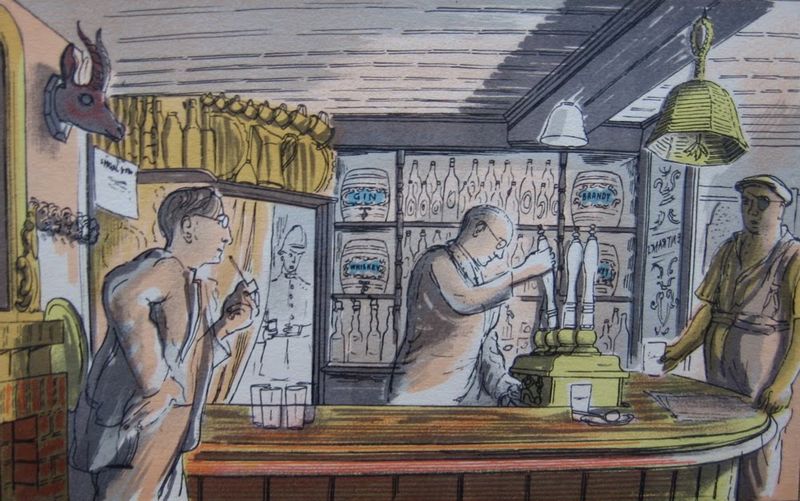
In 1938 he collaborated with John Aldridge, who also lived in the village, on a range of wallpapers, intended to be printed commercially, but from lino blocks handcut by the designers. The project left little other time for other work during the year, and war intervened, before the papers could go into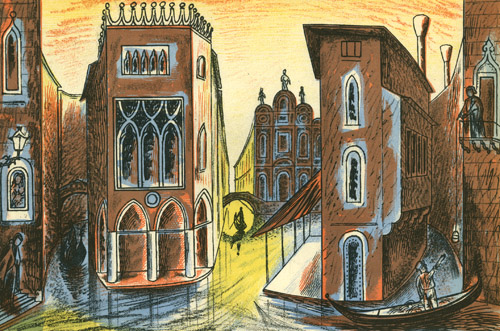 production.
production.
During the Second World War, Edward Bawden served as official war artist, first with the British army in France, and then, following the army's evacuation from there, in the Middle East.He made many evocative watercolour paintings recording the war effort in Iraq. Some show the unique life led by the Marsh Arabs in southern Iraq, particularly their dwellings made of reeds.
in southern Iraq, particularly their dwellings made of reeds.
 Essex from the 1930s to 1970. While living at Bardfield he was an important member of the Great Bardfield Artists. This group of local artists were diverse in style but shared a love for figurative art, making the group distinct from the better known St Ives art community in Cornwall, who, after the war, were chiefly dominated by abstractionists.
Essex from the 1930s to 1970. While living at Bardfield he was an important member of the Great Bardfield Artists. This group of local artists were diverse in style but shared a love for figurative art, making the group distinct from the better known St Ives art community in Cornwall, who, after the war, were chiefly dominated by abstractionists.
In 1949 Bawden provided illustrations for the book "London is London – A Selection of Prose and Verse by D. M. Low".
During the 1950s the Great Bardfield Artists organised a series of large ‘open house’ exhibitions which attracted national press attention. Positive reviews and the novelty of viewing art works in the artists own homes (including Bawden's Brick House) led to thousands visiting the remote village during the summer exhibitions of 1954, 1955 and 1958. As well as these shows the Great Bardfield Artists held several touring exhibitions of their work in 1957, 1958 and 1959.
After the death of his wife in 1970, Bawden moved to the nearby town of Saffron Walden, where he continued to work until his death.
He died at home on 21 November 1989, aged eighty-six.
Bawden's work can be seen in many major collections and is shown regularly at the Fry Art Gallery in Saffron Walden and the Bedford Museum & Art Gallery in Bedford.
in Saffron Walden and the Bedford Museum & Art Gallery in Bedford.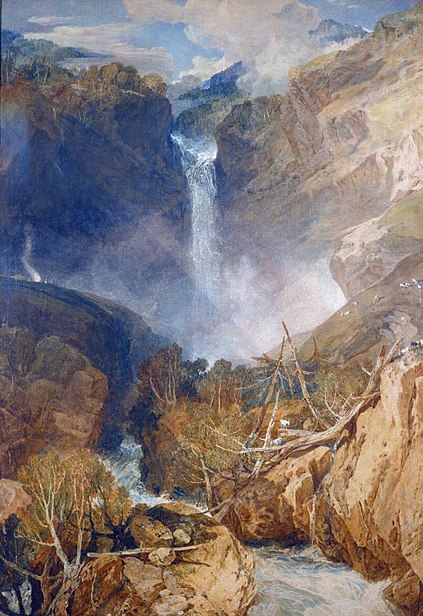
Having briefly taught design and book illustration at Goldsmith's College from 1928–1931, Bawden then went on to teach at the Royal College of Art from 1930 - 1963 (minus the War years). In 1968, Bawden became a tutor at the Royal Academy Schools and Senior Lecturer at Leicester College of Art and Design
 He was admired by Edward Gorey, David Gentleman and other graphic artists.
He was admired by Edward Gorey, David Gentleman and other graphic artists.
Edward Bawden was born in Britain on 10 March 1903, at Braintree
 , Essex, the only child of Edward Bawden (ironmonger) and Eleanor Bawden (née Game). His parents were Methodist Christians.
, Essex, the only child of Edward Bawden (ironmonger) and Eleanor Bawden (née Game). His parents were Methodist Christians. A solitary child he spent much time drawing or wandering with butterfly-net and microscope. At the age of seven he was enrolled at Braintree High School, and began studying or copying drawings of cats by Louis Wain,
A solitary child he spent much time drawing or wandering with butterfly-net and microscope. At the age of seven he was enrolled at Braintree High School, and began studying or copying drawings of cats by Louis Wain, and there, when he was fifteen, the headmaster recommended him to study for one day a week at Cambridge Municipal Art School (now Anglia Ruskin University). On leaving school in 1919 he attended the Cambridge School of Art full-time (1919 to 1921). Here he became interested in calligraphy and in the work of
and there, when he was fifteen, the headmaster recommended him to study for one day a week at Cambridge Municipal Art School (now Anglia Ruskin University). On leaving school in 1919 he attended the Cambridge School of Art full-time (1919 to 1921). Here he became interested in calligraphy and in the work of  Aubrey Beardsley, Richard Doyle, William Morris and other Victorians. This was followed in 1922 by a scholarship to the Royal College of Art School of Design in London, where he took a diploma in illustration until 1925.Here he met his fellow student and future collaborator,
Aubrey Beardsley, Richard Doyle, William Morris and other Victorians. This was followed in 1922 by a scholarship to the Royal College of Art School of Design in London, where he took a diploma in illustration until 1925.Here he met his fellow student and future collaborator,  Eric Ravilious; the pair were described by their teacher, Paul Nash, as "an extraordinary outbreak of talent
Eric Ravilious; the pair were described by their teacher, Paul Nash, as "an extraordinary outbreak of talentBy 1930 Bawden was working one day a week for the Curwen Press (as was Ravilious and their former tutor, Nash), producing illustrations for leading accounts such as London Transport, Westminster Bank, Twinings, Poole Potteries and Shell-Mex.
In 1928, Bawden was commissioned by Sir Joseph Duveen at the rate of £1 per day to create a mural for the Refectory at Morley College, London with Ravilious and Charles Mahoney. The mural was opened in 1930 by former Prime Minister Stanley Baldwin, at the time leader of the opposition, having ended his premiership in 1929.

In the early 1930s he was discovered by the famous Stuart Advertising Agency, owned by H. Stuart Menzies and Marcus Brumwell. At this time Bawden produced some of his most humorous and innovative work for Fortnum & Mason and Imperial Airways. It was also in this period that Bawden produced the tiles for the London Underground, which were exhibited at the International Building Trades Exhibition at Olympia in April 1928.

In 1932 he married Charlotte Epton, who had been a fellow-student at the Royal College.They would have two children - Joanna (b. 1935) and Richard (b. 1936), both of whom would become artists. At first the couple lived in a flat in Hammersmith, but soon moved to a Georgian house in Great Bardfield, Essex, only a few miles from Braintree, where Bawden was born. Following his move to the country he began to paint more, in addition to his commercial design work, developing his watercolour technique. Most of his subjects were of scenes around Great Bardfield. He held an exhibition of his Essex watercolours at the Zwemmer Gallery in 1934, and another show of his paintings was held at the Leicester Galleries in 1938.
In 1938 he collaborated with John Aldridge, who also lived in the village, on a range of wallpapers, intended to be printed commercially, but from lino blocks handcut by the designers. The project left little other time for other work during the year, and war intervened, before the papers could go into
 production.
production. in southern Iraq, particularly their dwellings made of reeds.
in southern Iraq, particularly their dwellings made of reeds.Bawden lived in Great Bardfield,
 Essex from the 1930s to 1970. While living at Bardfield he was an important member of the Great Bardfield Artists. This group of local artists were diverse in style but shared a love for figurative art, making the group distinct from the better known St Ives art community in Cornwall, who, after the war, were chiefly dominated by abstractionists.
Essex from the 1930s to 1970. While living at Bardfield he was an important member of the Great Bardfield Artists. This group of local artists were diverse in style but shared a love for figurative art, making the group distinct from the better known St Ives art community in Cornwall, who, after the war, were chiefly dominated by abstractionists.In 1949 Bawden provided illustrations for the book "London is London – A Selection of Prose and Verse by D. M. Low".

During the 1950s the Great Bardfield Artists organised a series of large ‘open house’ exhibitions which attracted national press attention. Positive reviews and the novelty of viewing art works in the artists own homes (including Bawden's Brick House) led to thousands visiting the remote village during the summer exhibitions of 1954, 1955 and 1958. As well as these shows the Great Bardfield Artists held several touring exhibitions of their work in 1957, 1958 and 1959.
After the death of his wife in 1970, Bawden moved to the nearby town of Saffron Walden, where he continued to work until his death.

He died at home on 21 November 1989, aged eighty-six.
Bawden's work can be seen in many major collections and is shown regularly at the Fry Art Gallery
 in Saffron Walden and the Bedford Museum & Art Gallery in Bedford.
in Saffron Walden and the Bedford Museum & Art Gallery in Bedford.
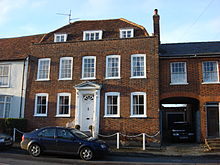
No comments:
Post a Comment